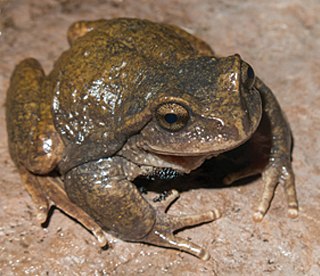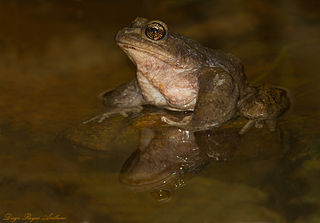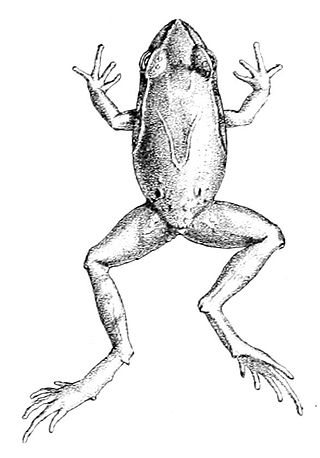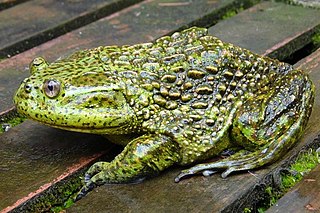
Telmatobufo is a genus of frogs endemic to southern Chile. Their closest living relative is the monotypic helmeted water toad, Calyptocephalella gayi. These frogs were recently removed from the Leptodactylidae and placed in a new family, the Calyptocephalellidae. All three species of Telmatobufo that have been assessed by the IUCN are considered threatened.

The mountain toad is a species of toad in the family Bufonidae. It is endemic to the Sierra de los Tuxtlas region in southern Veracruz state, Mexico.
Rhinella rubropunctata is a species of toad in the family Bufonidae that is found in southern Chile and Argentina. Its natural habitats are humid to xeric temperate forests and open environments. It tolerates a certain degree of disturbance. Breeding takes place in shallow temporary ponds near rivers, reservoirs and lakes. It is threatened by habitat degradation and fragmentation.
Werneria preussi is a species of toad in the family Bufonidae. It is found in southwestern Cameroon and—highly disjunctly and based on a more than 100 years old record—in Togo. Some sources also mention Equatorial Guinea.

Nymphargus rosada is a species of frog in the family Centrolenidae, formerly placed in Cochranella. It is endemic to Colombia where it is known from the eastern slopes of the Cordillera Central. Its natural habitats are sub-Andean forests alongside streams. It is threatened by habitat fragmentation and loss caused by agricultural expansion, timber extraction, and water pollution.
Nymphargus ruizi is a species of frog in the family Centrolenidae, formerly placed in Cochranella. It is endemic to Colombia where it is known from the western slopes of the Cordillera Occidental and the eastern slopes of the Farallones de Cali. Its natural habitats are sub-Andean forests next to streams. It is threatened by habitat loss caused by agricultural expansion, logging, human settlement, and water pollution.
Phrynomedusa vanzolinii, or Vanzolini's leaf frog, is a frog in the subfamily Phyllomedusinae. It is endemic to southeastern Brazil where it is currently known from Teresópolis in the state of Rio de Janeiro and Boraceia in the state of São Paulo, Brazil. It is possible that this species is a synonym of Phrynomedusa appendiculata.

Leptopelis macrotis, sometimes called the big-eyed forest tree frog, is a species of frog in the family Arthroleptidae. It is found in the rainforests of Sierra Leone, southern Guinea, Liberia, Ivory Coast, and southern Ghana. Notice that similar common name "big-eyed tree frog" is sometimes used for Leptopelis vermiculatus from Tanzania and for Litoria exophthalmia from New Guinea.
Leptopelis modestus is a species of frog in the family Arthroleptidae. Its common names are modest forest treefrog and plain tree frog.

Alsodes australis is a species of frog in the family Alsodidae found in western Argentina and eastern Chile from 46°25′S to 42°25′N. Its natural habitat is cold mountain streams of austral temperate Nothofagus forest. A potential threat to this species are introduced predatory salmonid fishes, but so far little is known about its population status.

Alsodes barrioi, the Cabreria spiny-chest frog, is a species of frog in the Alsodidae, endemic to Chile; it is only known from its type locality in the Cordillera de Nahuelbuta, Malleco Province. The specific name barrioi honors Avelino Barrio, a Spanish botanist and zoologist who lived in Argentina.

Alsodes hugoi is a species of frogs in the family Alsodidae. It is endemic to Chile and only known from its type locality, Río Lircay, in Alto de Vilches, Talca Province, on the western slopes of the Andes. The specific name hugoi honors Professor Hugo Campos Cereceda, for his "remarkable contributions to the development of the natural sciences in Chile".

Alsodes nodosus is a species of frog in the family Alsodidae endemic to central Chile; records from Argentina are not considered valid.

Alsodes verrucosus is a species of frog in the family Alsodidae. It is found in the Andes of Chile and Neuquén and Río Negro Provinces, Argentina. These frogs inhabit temperate Nothofagus forest where they occur under logs and near damp areas. Tadpoles develop in cold, deep streams. It is threatened by habitat loss caused by logging.

Eupsophus calcaratus is a species of frog in the family Alsodidae. It is endemic to Patagonia. It has one of the broadest distributions of any Chilean frog.

Eupsophus emiliopugini is a species of frog in the family Alsodidae. It is found in the temperate Nothofagus forests of Chile between 40°50'S and 45°20'S, and in the Lago Puelo National Park, Chubut Province, Argentina. The specific name emiliopugini honors Professor Emilio Pugín, for "his contribution to knowledge of the reproductive biology and development of the Chilean frogs". Common name Emilio's ground frog has been coined for the species.

Telmatobufo bullocki is a species of frog in the family Calyptocephalellidae. It is endemic to Chile, and is only known from a few locations in the Cordillera de Nahuelbuta, a part of the Chilean Coast Range. It is extremely rare; extensive fieldwork in 1992–2002 turned up only a single adult. It occurs in fast-flowing streams in temperate Nothofagus forest. The tadpoles are free-swimming and feed on algae growing on submerged rocks. It is threatened by siltation of streams caused by clear-cutting. It occurs within the Nahuelbuta National Park.

Telmatobufo venustus is a species of frog in the family Calyptocephalellidae. It is endemic to Chile and occurs on the western slopes of the Andes in Maule and Bío Bío Regions. Its natural habitats are streams in temperate Nothofagus forests where it is found under rocks along the streams. The only stable population is in the Altos de Lircay National Reserve in Maule. The only other localities, both in the Bío Bío Region, are its type locality in Chillan, where it was not found in 2014, and Ralco where it was last observed in 1981. It is threatened by habitat loss caused by fires, conversion of native habitat to pine and eucalyptus plantations, and in Ralco, hydropower dams. Trout in Altos de Lircay are also a threat.
The Hewitt's ghost frog is a species of frog in the family Heleophrynidae. It is endemic to Eastern Cape Province, South Africa. Its natural habitat is fynbos heathland and grassy fynbos. Adults are difficult to see but live in or near fast-flowing perennial rivers and streams where they also breed. Each female lays up to 200 eggs. Tadpoles are more readily seen and take two years to develop fully.

The Calyptocephalellidae are a family of toads found in Chile containing two living genera, Calyptocephalella and Telmatobufo.














